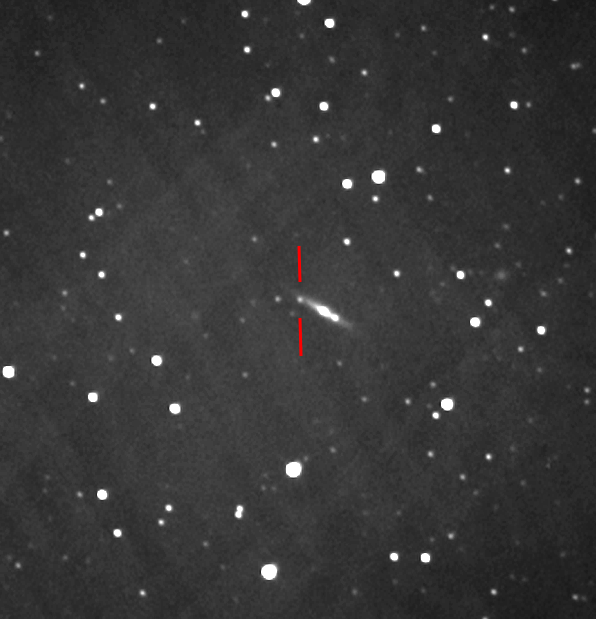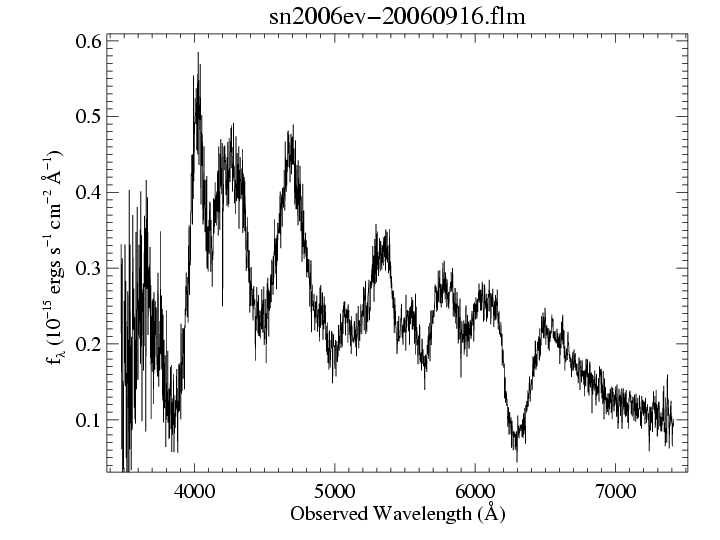Dans la nuit du 12 au 13 septembre 2006, une fois de plus en pleine recherche d’astéroïdes, nous avons découvert une « nouvelle » étoile dans la galaxie UGC11758 située dans la constellation de Pégase.
Ceci est la deuxième supernova découverte à l’Observatoire par Michel Ory. Cette supernova est de type Ia. Ce type constitue un précieux indicateur de distance pour les astronomes.
Fait exceptionnel, cette étoile en fin de vie à été détectée moins de 48h après son explosion. Sa magnitude mesurée est de 16.6R, ce qui correspond à environ 360 millions d’années-lumière. L’explosion de cette étoile a donc en fait eu lieu durant l’ère primaire!
Image du TBC à l’Observatoire

Image d’archive STScI

Son spectre
Quelques jours plus tard, le télescope de 1.5m de l’Observatoire Fred Lawrence Whipple sur le Mont Hopkins (Arizona) mesurait avec précision le spectre de la supernova donnant donc son type Ia.
Le télégramme d’annonce de l’Union astronomique internationale
Electronic Telegram No. 622
Central Bureau for Astronomical Telegrams
INTERNATIONAL ASTRONOMICAL UNION
M.S. 18, Smithsonian Astrophysical Observatory, Cambridge, MA 02138, U.S.A.
IAUSUBS@CFA.HARVARD.EDU or FAX 617-495-7231 (subscriptions)
CBAT@CFA.HARVARD.EDU (science)
URL http://cfa-www.harvard.edu/iau/cbat.html
SUPERNOVAE 2006eu AND 2006ev
S. Blondin, M. Modjaz, R. Kirshner, and P. Challis, Harvard-Smithsonian Center for Astrophysics, report that spectra (range 350-740 nm) of SN 2006eu (cf. IAUC 8745) and SN 2006ev (cf. IAUC 8747), obtained on Sept. 16.20 and 16.26 UT by M. Calkins with the F. L. Whipple Observatory 1.5-m telescope (+ FAST), shows them to be both type-Ia supernovae. Cross-correlation with a library of supernova spectra shows that 2006eu is most similar to the 1991bg-like supernova 1998bp (cf. IAUC 6891) at +13.4 days from maximum light, and that 2006ev is most similar to SN 1992A (Kirshner et al. 1993, Ap.J. 415, 589) at +3.3 days. Adopting a recession velocity of 7071 km/s for the host galaxy of SN 2006eu (from Huchra et al. 1999, Ap.J. Suppl. 121, 287), the maximum absorption in the Si II line (rest 635.5 nm) is blueshifted by roughly 11000 km/s. Adopting a recession velocity of 8576 km/s for the host galaxy of 2006ev (from http://tdc-www.harvard.edu/uzc/), the maximum absorption in the Si II line (rest 635.5 nm) is blueshifted by roughly 12000 km/s.
NOTE: These ‘Central Bureau Electronic Telegrams’ are sometimes superseded by text appearing later in the printed IAU Circulars.
La circulaire officialisant la découverte
Pour la petite histoire, l’annonce officiel de cette découverte a été faite dans le même communiqué (circulaire IAUC 8747) qui annonçait la rétrogradation de Pluton de son status de planète à celui de « simple » astéroïde.
Circular No. 8747
Central Bureau for Astronomical Telegrams
INTERNATIONAL ASTRONOMICAL UNION
Mailstop 18, Smithsonian Astrophysical Observatory, Cambridge, MA 02138, U.S.A.
IAUSUBS@CFA.HARVARD.EDU or FAX 617-495-7231 (subscriptions)
CBAT@CFA.HARVARD.EDU (science)
URL http://cfa-www.harvard.edu/iau/cbat.html
ISSN 0081-0304 Phone 617-495-7440/7244/7444 (for emergency use only)
(134340) PLUTO, (136199) ERIS, AND (136199) ERIS I (DYSNOMIA)
Following the Aug. 24 resolution by the IAU to the effect that the solar system contains eight « planets » (Mercury-Neptune), with (1) Ceres, Pluto (cf. IAUC 255), and 2003 UB_313 (cf. IAUC 8577) to be considered representative « dwarf planets », the Minor Planet Center included Pluto and 2003 UB_313 (along with two other new potential dwarf-planet candidates) in the standard catalogue of numbered objects with well-determined orbits as (134340) and (136199), respectively (see MPC 57525). Following near-unanimous acceptance by both the Committee on Small-Body Nomenclature and the Working Group on Planetary-System Nomenclature (in consultation with the discovery team), the IAU Executive Committee has now approved the names Eris for (136199) and Dysnomia for its satellite (136199) Eris I [formerly S/2005 (2003 UB_313) 1; cf. IAUC 8610].
COMET 178P/HUG-BELL
Comet P/1999 X1 = 2006 O1 (cf. IAUC 8730) has been given the permanent number 178P (cf. MPC 57382).
COMET P/2006 R1 (SIDING SPRING)
Additional astrometry and the following improved orbital elements for this comet (cf. IAUC 8744) appear on MPEC 2006-R47. The orbital period, P, is the shortest known for a comet with a retrograde orbit.
T = 2006 Sept. 3.833 TT / Peri. = 249.322
e = 0.68901 / Node = 218.561 2000.0
q = 1.66976 AU / Incl. = 160.021
a = 5.36919 AU / n = 0.079221
P = 12.4 years
SUPERNOVA 2006ev IN UGC 11758
Michel Ory, Vicques, Switzerland, reports the discovery of an apparent supernova (red mag approximately 16.6) on CCD images taken on Sept. 12.9 and 13.8 UT with a 0.61-m f/3.88 reflector. The new object is located at R.A. = 21h30m59s.26 +/- 0s.05, Decl. = +13o59’21 ».2 +/- 0″.2 (equinox 2000.0), which is 23″ east and 11″ north of the nucleus of UGC 11758. Nothing is visible at this location on a red Palomar Sky Survey plate from 1953 Aug. 19 or a red U.K. Schmidt Telescope plate from 1991 Aug. 14.
(C) Copyright 2006 CBAT
2006 September 13 (8747) Daniel W. E. Green

